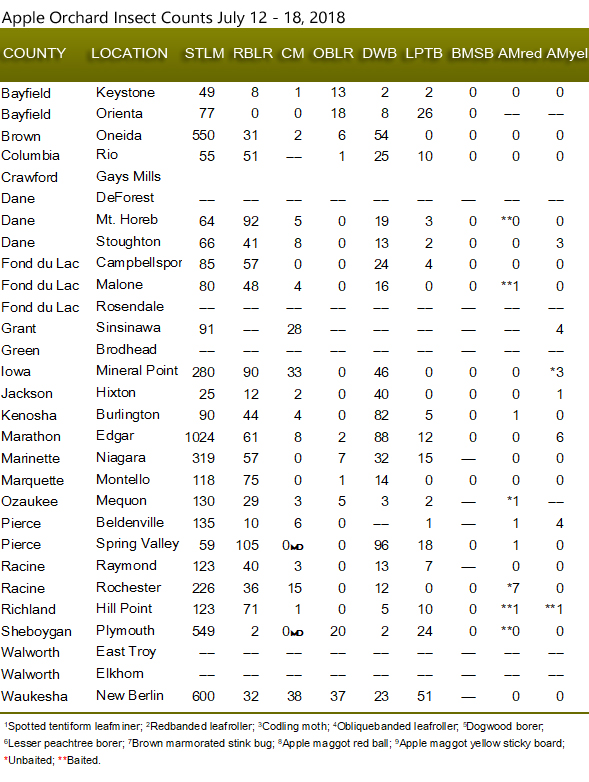
 |
|
|
Fruits
Volume 63 Number 12 Date 07/19/2018 JAPANESE BEETLE - Apple orchards in southern and western Wisconsin are reporting heavy beetle populations (especially on 'Honeycrisp'), with significant damage to foliage and the terminal ends of branches along orchard perimeters. If the beetles are causing unacceptable injury and treatment is required, growers can minimize insecticide use by spot treating only the most infested varieties. Insecticide options for this pest are limited. Growers who prefer a reduced-risk approach can apply a neonicotinoid at the first sign of feeding injury and before large aggregations appear. Neonicotinoids, e.g., Assail (acetamiprid), Actara (thiamethoxam), offer good repellency and mortality within a few days. Additionally, imidacloprid products, e.g., Admire Pro, Alias, and Wrangler, applied for apple maggot have anti-feeding properties and should also offer some Japanese beetle repellency. Where large aggregations have already formed and pressure is severe, a combination of a broad-spectrum insecticide, e.g., 1 - 2 lb. of Imidan (phosmet) tank mixed with a neonicotinoid may give much better management of this pest. Carbamates and pyrethroids are also effective but are much more disruptive to biological controls and other natural enemies that may be active in the orchard. Never spray when bees are foraging. Organic producers have the option of applying PyGanic (pyrethrins) or neem (azadirachtin) oil products, e.g., Azadirect, Neemix, and Trilogy. It is important to be aware that a botanical insecticide such as neem may be phytotoxic if tank-mixed with other pesticides. If these treatments are required late in the season, be aware of pre-harvest intervals. -- Control recommendations provided by Peter Werts, Specialty Crops Project Manager, IPM Institute of North America, Inc. CODLING MOTH - Most apple orchards are beyond the summer biofix and treatments targeting second-generation larvae have started. Pheromone trap counts should be used at this time to assess efficacy of first-generation control or to identify a deficiency in the current codling moth management program. According to John Aue of Threshold IPM Services, orchards with counts that remain uniform from trap to trap during the second flight likely have a local, in-orchard population. If using organophosphates (Imidan) for control of the summer generation, growers should replace trap liners before an application to monitor the effectiveness of the material. Moth counts that do not decline to zero or near-zero following treatment suggest resistance issues have developed and use of organophosphate material should be discontinued. APPLE MAGGOT - Emergence continued in the past week in Wisconsin orchards. Economic counts of 3-7 flies per unbaited trap were reported from Grant, Iowa, Marathon, Pierce and Racine counties. Growers should reapply sticky coating to traps and maintain apple maggot controls as long as counts exceed the established economic thresholds of one fly per trap per week on unbaited traps or five flies per trap per week on baited traps. OBLIQUEBANDED LEAFROLLER - Larvae are primarily in the late instars and pupal stages in the southern and western counties. Beyond the first and second instars, this leafroller becomes increasingly difficult to control and much of its feeding damage has already occurred. Emergence of the summer brood of moths is anticipated by August. RASPBERRY CANE BORER - Raspberry canes in Dane County are showing wilted, blackened tips caused by this wood-boring beetle. Borer damage can be identified by two rings about 1/2 inch apart located 4-6 inches below the growing tip. An egg is inserted into the cane between the two rings. Symptoms become more conspicuous as the larva burrows to the base of the cane, causing the entire cane to die before the fruit matures. Infested tips should be pruned several inches below the lowest girdle mark as soon as they are noticed. SPOTTED TENTIFORM LEAFMINER - The second flight has peaked in most southern and central apple orchards and sapfeeder larvae are reappearing. The economic threshold for the third and final generation increases to five mines per leaf. SPOTTED WING DROSOPHILA - Infestations of small fruits are intensifying, and damage is already being reported on some fruit farms and in community gardens. Cultural management practices are particularly important for reducing SWD infestation and population buildup at this time. Netted exclusion of the plant canopy, sanitation and orchard/berry floor management, and cooling fruit to 34-38°F immediately after harvest are all advised. Chemical control of SWD is intensive and involves insecticide applications at the onset of adult activity to prevent adult egg laying, short intervals between sprays, and insecticide rotation. For organic operations, the OMRI-approved insecticides PyGanic and Entrust are available. A list of insecticide options for conventional small fruit growers can be found on the UW-Madison SWD website: http://labs.russell.wisc.edu/swd/management-2/. POTATO LEAFHOPPER - Pressure is reportedly high in northwestern Wisconsin. One- to two-year-old, non-bearing apple trees are most susceptible to leafhopper feeding and should be monitored for leaf curling and yellowing caused by the adults and nymphs. Treatment is justified at levels of one or more nymphs per leaf when symptoms are evident. -- Krista Hamilton, DATCP Entomologist 





|
|
|